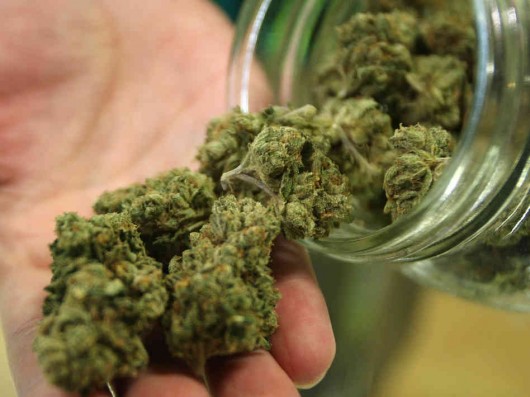In November, Alaska voters will decide whether to approve Ballot Measure 2, which would legalize marijuana in the state. During Wednesday’s Ketchikan Chamber of Commerce lunch, a Ketchikan Police Department officer who focuses on drug enforcement talked about the cons of legalization. But, the coordinator for the statewide effort to pass the ballot measure said those arguments are scare tactics.
Sergeant Andy Berntson said pot is nothing like it was 20 year ago.
“People are taking the plant, the most basic bud form, and trying to get a higher high, then an even more higher high, and a more concentrated high,” he said. “Basically, people have come up with a system of making a ‘crack weed’ though a chemical process that is very destructive and dangerous.”
Some of the terms for concentrated forms of marijuana include “ear wax” “budder” and “butane hash oil.” Butane is used to extract the plant resin, then grain alcohol is added and the mixture is cooked until it thickens into a concentrated form that can be smoked. Berntson said that production process has led to explosions.
In addition, the concentrated marijuana extract is significantly more potent than the plant form.
“Years ago, you were dealing with 1 to 2 percent. Like Woodstock weed, grass,” he said.
Now, Berntson said, the levels of THC in the new, concentrated forms are 80 to 90 percent.
He also expressed concern about how legalization could affect youth. Berntson said drug use among young people already is a problem.
“Anytime you make something more readily available, there’s just no way you’re not going to increase the abuse,” he said.
Berntson added that candy, cookies and other edible items laced with THC could be accidentally ingested by children, who definitely shouldn’t be exposed to concentrated levels of marijuana. He used a power point presentation provided by Big Marijuana Big Mistake, a state organization that opposes Ballot Measure 2, and showed images of colorful marijuana-infused suckers, plus “Kif Kat” and “Krondike” candy bars.
Berntson said that marijuana at any level of exposure can be harmful. He said it can increase anxiety, lead to panic attacks and reduce cognitive abilities over the long term – especially among young users whose brains are still developing.
Berntson also talked about the Vote Yes on 2 campaign, and said it’s funded by a national organization.
“This is not a grass-roots, in-state push,” he said. “This is a national organization that picked Alaska because they saw us as an easy target.”
But, the state coordinator for the Vote Yes on 2 campaign disagrees.
“This initiative is only on the ballot because over 40,000 Alaskans signed a petition to qualify the petition for the ballot,” said Taylor Bickford. “And so to suggest that this is anything but a homegrown cause that Alaskans support I just think is an insult to the intelligence of average voter in the state, and it’s ultimately going to be Alaskans and Alaskan voters who decide this issue in November.”
Bickford said regulation of marijuana does make sense for Alaska, in part because the state has the highest levels of use in the country already.
“So whether we regulate it or not, it’s going to be available in Alaska from somebody,” he said. “And currently, marijuana sales are entirely controlled by criminal enterprises operating in the black market.”
In response to an argument that a black market for marijuana would continue, because illegal pot would be cheaper and available to youth, Bickford said that’s a ridiculous notion. He said there aren’t thriving black markets for alcohol or tobacco, so “to suggest that taxing and regulating marijuana will do anything but put drug dealers out of business and take this industry out of the hands of criminals is a ridiculous argument to make, and is not supported by any objective evidence or facts or examples from any other jurisdictions in the world that have make this policy change.”
Bickford also responded to the argument that marijuana is a dangerous drug that should remain illegal because of the potential health effects. He said marijuana is safer than alcohol, even in its concentrated form.
“The prohibitionists in this state are doing what they’ve always done; they’re trying to scare and confuse Alaskans into thinking that marijuana is more dangerous than it actually is,” he said.
In his presentation, Berntson was asked about alcohol abuse, and how it compares to marijuana abuse. Berntson responded that there wasn’t much of a difference.
“My argument to that would be, well, let’s leave bad enough alone,” he said. “Let’s not add to our problems.”
Marijuana already is kind of legal in the state. The laws are complicated, but essentially adults can have up to 4 ounces in their own home. But, it’s still illegal to buy or sell marijuana.
Alaskans still have a few months left to think about this issue. The initiative will be on the Nov. 4th general election ballot.
For more arguments from both sides of the issue, see the following websites:
Vote Yes on 2 campaign: http://www.regulatemarijuanainalaska.org/
Big Marijuana, Big Mistake: http://www.bigmarijuanabigmistake.org/






